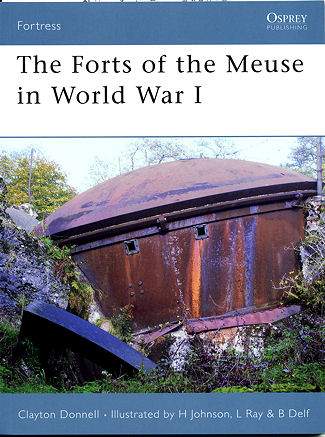 This is
#60 in the Fortress series and concentrates on the fixed fortifications built in
1891 around the cities of Liege and Namur in Belgium. This was the area of
greatest concern from invading German armies as it was the cross roads of rail
and highways as well as the area most likely to have the armies cross the Meuse
river. Hence the Forts of the Meuse. This area was equally as strategic in WWII
and equally fortified, but I'm getting ahead of myself.
This is
#60 in the Fortress series and concentrates on the fixed fortifications built in
1891 around the cities of Liege and Namur in Belgium. This was the area of
greatest concern from invading German armies as it was the cross roads of rail
and highways as well as the area most likely to have the armies cross the Meuse
river. Hence the Forts of the Meuse. This area was equally as strategic in WWII
and equally fortified, but I'm getting ahead of myself.
The need was there for a series of fortifications to help
stave off invading armies, so a huge effort was made to produce a series of
forts. As is often the case, when there is no war on the horizon, money was
provided, but insufficient to build a complete series of fortifications as
envisioned by the planners. The result was that engineers had to choose quite
carefully where to put these forts and other structures. Designed by Brialmont,
one of the foremost engineers of the time, 21 forts were eventually built,
complete with weapons in 'disappearing' turrets. Despite all the most modern
amenities, several of the forts had to eventually surrender due to the lack of
proper waste disposal that made the fortresses uninhabitable after just a short
period of time, as latrines were situated in areas that were easily bombarded by
the invading German Army!
The author provides a fascinating look into the design and
construction of these forts, one of the largest engineering projects of its
time. He also provides insight into the usual political machinations that
precede the development of just about any military project, something we see
even today. The world has no shortage of short-sighted politicians.
In addition to the development of these forts, their full
operational history in the opening days of WWII are covered. Though eventually
overrun, they were able to slow the invading Germans long enough for
reinforcements from France and the UK to arrive and prevent a total overrunning
of France that eventually led to the prolonged trench warfare that has become
symbolic of WWI. Despite being overrun, much was learned from these forts and
allowed the Belgians to build even better ones like the one at Eban Emael in the
same area. But that is another story.
This is all superbly illustrated by H. Johnson, L.Ray and B.
Delf, giving us a superb look at how these forts developed and were sustained.
Add in a fine collection of period photographs and you have an excellent book on
a subject that is both historically significant and fascinating to read. It is
one I can highly recommend.
February 2007
For more on the complete line of Osprey books,
visit www.ospreypublishing.com. In the US, it is
Osprey Direct at 44-02 23rd St, Suite 219, Long Island City, NY 11101., where you can
get a catalogue of available books.
If you would like your product reviewed fairly and quickly by a
site that has nearly 350,000 visitors a month, please contact
me or see other details in the Note to
Contributors.
 This is
#60 in the Fortress series and concentrates on the fixed fortifications built in
1891 around the cities of Liege and Namur in Belgium. This was the area of
greatest concern from invading German armies as it was the cross roads of rail
and highways as well as the area most likely to have the armies cross the Meuse
river. Hence the Forts of the Meuse. This area was equally as strategic in WWII
and equally fortified, but I'm getting ahead of myself.
This is
#60 in the Fortress series and concentrates on the fixed fortifications built in
1891 around the cities of Liege and Namur in Belgium. This was the area of
greatest concern from invading German armies as it was the cross roads of rail
and highways as well as the area most likely to have the armies cross the Meuse
river. Hence the Forts of the Meuse. This area was equally as strategic in WWII
and equally fortified, but I'm getting ahead of myself.